Updated Oct. 1, 2024, 23:47 ET.
Cambodia’s plan to build a canal linking its capital to the coast to end dependence on Vietnamese ports has raised a barrage of questions about its economic viability and environmental impact.
An RFA reporter traveled the proposed route of the waterway and spoke to residents who will be relocated. First in a two-part series.
Mot Yen’s ramshackle kitchen is nestled under an old mango tree. It’s near the end of the season and there’s no fruit on the branches. Part of the kitchen wall has fallen off but the family doesn’t plan to fix it. “We’re moving anyway,” the 56-year-old farmer said.
Just a couple of hundred meters (yards) away from her house in Chey Oudom 2 village in Kien Svay District, Kandal Province, is a construction site where the Cambodian government held a groundbreaking ceremony for former leader Hun Sen’s monumental project – the Funan Techo Canal – on Aug. 5.
Hundreds of people were invited to the launch of the US$1.7 billion project, waving flags and floating balloons as celebratory drums beat and Buddhist monks chanted blessings.
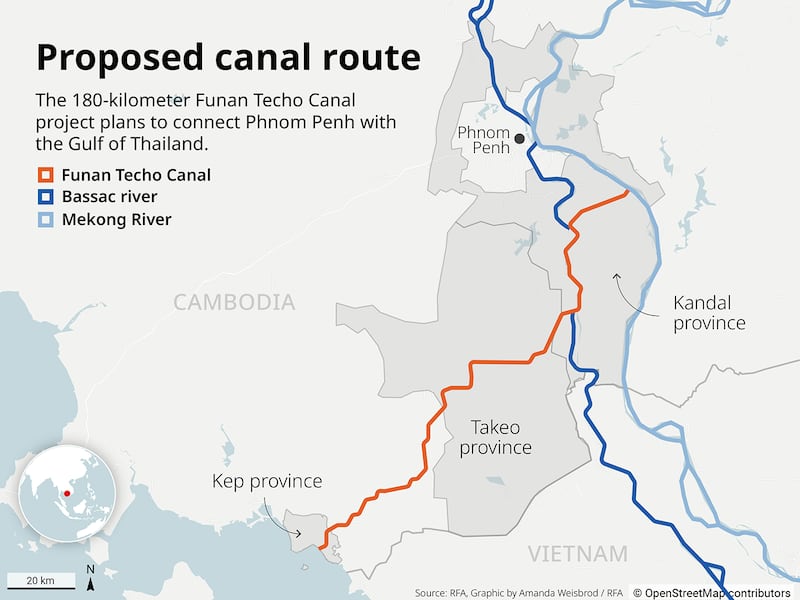
The 180-kilometer (112-mile) waterway will connect the Mekong River at the capital, Phnom Penh, and the inland provinces of Kandal and Takeo with the province of Kep on the Gulf of Thailand.
Crucially, it will cut reliance on neighboring Vietnam to the south as Cambodia’s gateway to world markets.
Prime Minister Hun Manet promised in his speech that the canal – his father’s brainchild – will boost the economy, strengthen independence, promote trade, industry, agriculture and logistics and ensure efficient water management.
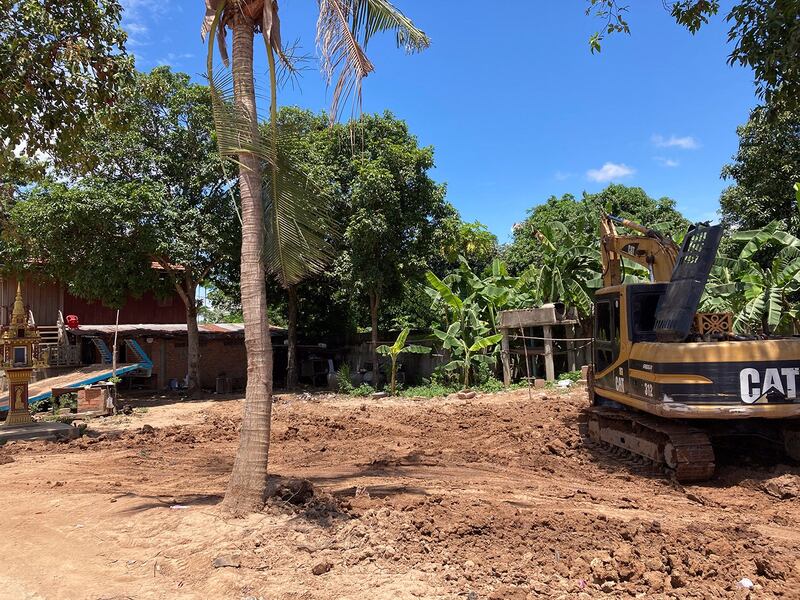
But it will also displace thousands of homes and swallow up chunks of farmland along the canal – and residents say they haven’t been given clear terms of compensation.
Vietnam, meanwhile, is alarmed by the prospect of the China-backed canal reducing the flow of water down the Mekong to its vital rice-growing delta but the Cambodian government has given its old ally short-shrift, dismissing its worries.
‘Really frustrating’
Weeks after the groundbreaking there was no sign of progress on the project. A sluggish brown creek off the Mekong skirts a Chinese-built fertilizer plant adorned with a big banner declaring “We all support Funan Techo Canal.”
“We all support the canal project,” confirmed village chief Thong Naren.
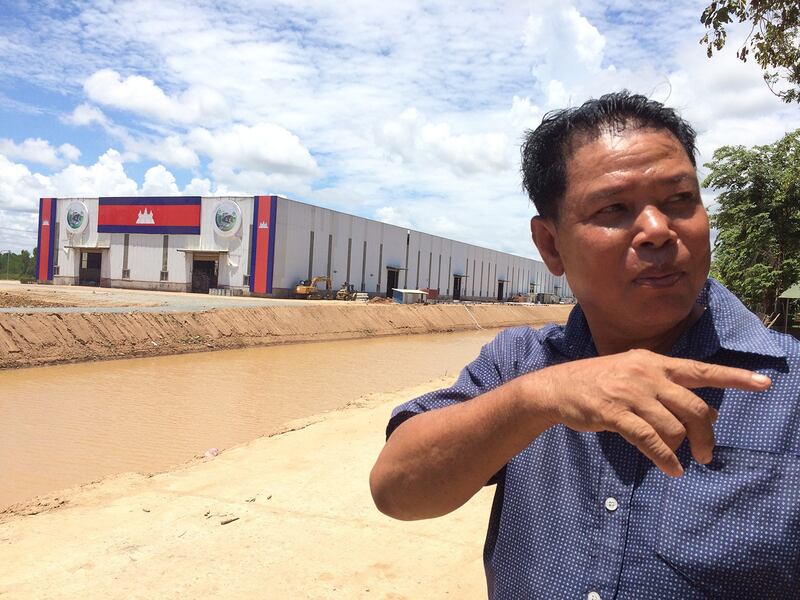
The government has mounted a spirited campaign to promote the canal to the public, about how it will bring water to parched rice fields, change people’s lives and cut transport costs.
“Ships will travel back and forth every day,” said Thong Naren, adding that tourists might come to watch the splendid sight. “As a citizen of Cambodia, I am very proud of the project.”
However, Thong Naren and others are concerned about what they feel is a lack of information about compensation the government will give for them for relocating, as well as the impact on the environment and the river, which underpin their livelihoods.
“There’s nothing good about relocating,” the farmer Mot Yen said. “When we go to a new place we’ll have to replant all our crops. Worse still, we don’t know where we’ll be moving to.”
The villagers are adamant that they will only agree to move after getting proper compensation but nobody knows when that might happen.
“It’s really frustrating for us,” she added.
‘A lot of fanfare’
Many farmers share the frustration, an RFA reporter learned on a trip along the canal's proposed course from Kandal and Takeo to Kep.
Takeo farmer Kean Ya, 62, said that although he had heard that the canal would run through his land there had been no word on compensation.
“Not only me, but more than 100 households in this area will be affected but no one has come to see us, no one has spoken to us at all,” he said. “I don’t even want compensation, I just wish they wouldn’t build the canal here.”
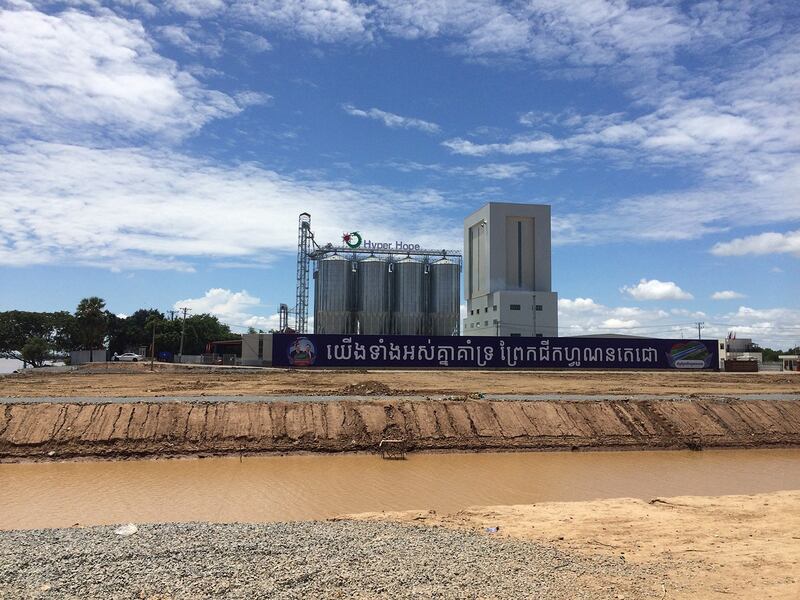
The government has acknowledged that the compensation process needs to speed up and has called for patience. Authorities have yet to announce compensation rates and have also revised estimates of the extent of the project’s impact.
First vice-chairman of the Council for the Development of Cambodia, Sun Chanthol, told media in July that the project would affect 1,585 households, nearly 370 acres (150 hectares) of residential land and 7,200 acres (2,910 hectares) of rice fields and plantations.
But just weeks later that projection was revised up sharply to about 10,000 homes, 30 bridges, 36 roads, 600 dams and smaller canals and more than 7,000 hectares of farmland.
Yet Sun Chanthol, at a recent meeting at the Center for Strategic and International Studies in Washington, said according to the latest estimates, 2,305 households would be affected.
While villagers are in the dark, it seems government planners are still finalizing details of the canal’s route. Some settlements, told to prepare to move, were later told to stay put, residents said.
The government has yet to announce the name of the company that will oversee the construction.
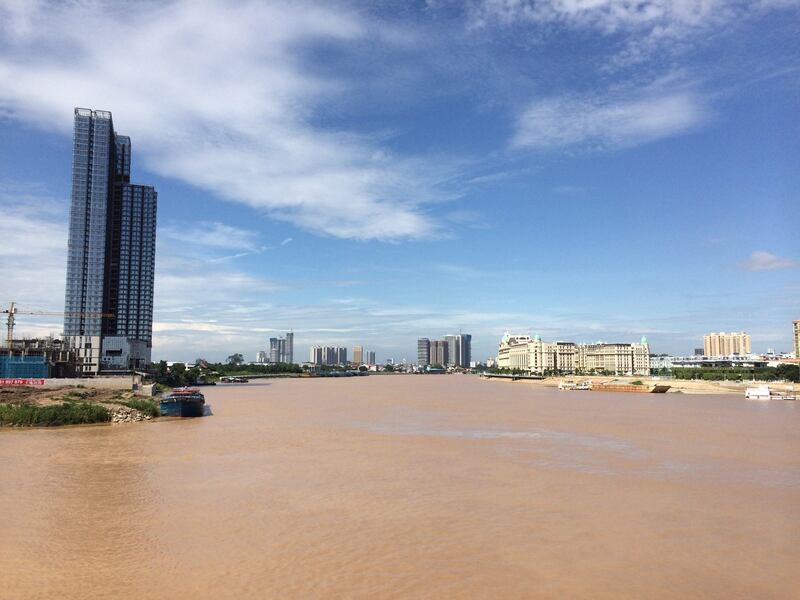
“This is so typical Hun Sen,” said a Cambodian analyst, who declined to be identified, expressing skepticism about the project in a country where dissenting voices have for years been threatened or worse.
“A lot of fanfare for something just half-ready.”
Radio Free Asia contacted authorities overseeing the project to ask about progress but they declined to respond.
'Techo'
Cambodian researchers and analysts were reluctant to discuss the possibility of any problems with the Funan Techo canal and the domestic media only focused on the much-trumpeted benefits.
The canal, officially known as the Tonle Bassac Navigation Road and Logistics System Project, was proposed and approved when Hun Sen was prime minister, and is being publicly acclaimed as one of the veteran leader’s great legacies.
The word “techo” in the canal’s title -- meaning “powerful” in Khmer -- is an echo of Hun Sen’s honorary title, Samdech Techo, which is evoked in many other Cambodian projects. This project was officially launched on his birthday, Aug. 5.
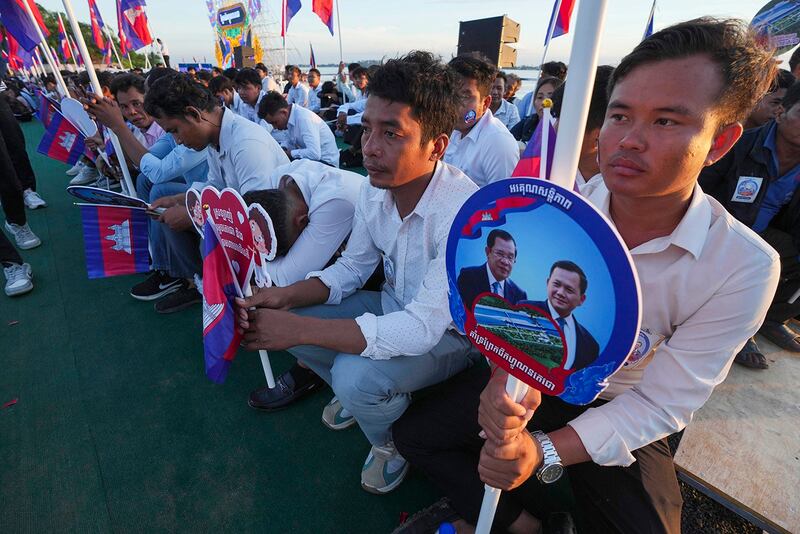
“Hun Manet as his father’s chosen heir had no choice but to announce that the government and the people of Cambodia will build the canal at any cost,” the Phnom Penh-based Cambodian analyst said.
Political activist Lim Kimsor said that essentially the canal is a “trade deal” between Cambodian government officials and foreign businesses, in particular Chinese.
“First of all, it’s a business project,” Lim said from self-exile in an undisclosed location.
“Hun Manet says it will help Cambodian people but it will not,” said the former activist from the Mother Nature Cambodia environmental group. “Our agricultural sector is not performing well and we don’t have much to export.”
She accused the government of selling out “our trees and natural resources to China and Vietnam.”
“The future canal may be good for that purpose, but not to benefit the people.”
Questions on timeframe, budget
Foreign observers question the viability of the project - one of the largest infrastructure projects in Cambodia - and say the timeframe of four-to-six years to build it is unrealistic.
In comparison, planners looking into the possibility of a 100-kilometer (60-mile) canal across southern Thailand’s Kra Isthmus said it would take 10 years to complete at a cost of about US$28 billion.
Brian Eyler, Southeast Asia program director at the Washington-based Stimson Center think tank, told RFA that the Cambodian project “appears to be on shaky financial grounds.”
“The ownership and financing details change on this project from month to month,” said Eyler.
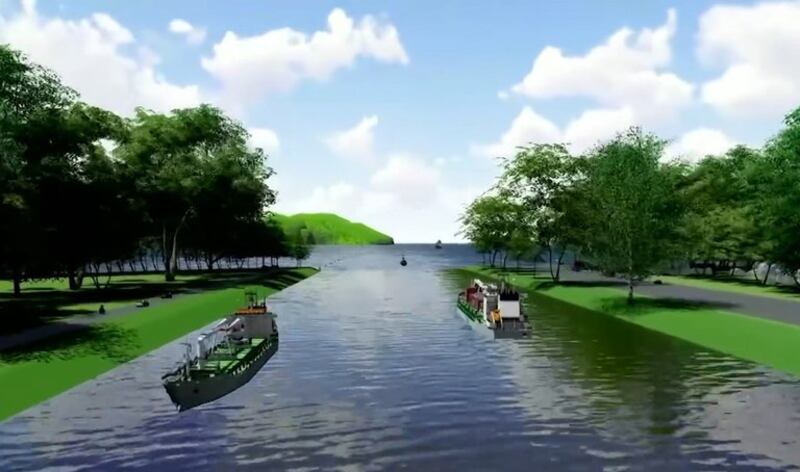
Hun Manet said at the ground-breaking ceremony that instead of being a foreign-invested project – a Chinese state company was initially reported to be the main investor under the Belt and Road Initiative – the canal was now being built mostly with Cambodian money.
Cambodians will make up a controlling 51% share of the investment needed, he said.
The prime minister’s announcement was aimed at dispelling concerns about China’s control over the canal but it raised a new question about financing. Cambodia is still one of the poorest countries in Southeast Asia, and it remains unclear where the money will come from.
Another Cambodian analyst, Vannarith Chheang, said that the government’s estimated cost of construction of US$1.7 billion may be too low.
"It might be challenging to realize the project with the current budget estimate," Vannarith told a webinar held by a Singaporean think tank – the ISEAS–Yusof Ishak Institute.
Some economists say it would still be cheaper to transship Cambodian exports via Vietnamese ports instead of going along the canal to a yet-to-be-upgraded port in Kampot.
At a depth of 5.4 meters (18 feet), the canal will only be able to accommodate ships of up to 5,000 tons. Larger vessels would still have to use the Vietnam route.
Hun Sen's arch enemy and a former finance minister, veteran opposition leader Sam Rainsy, argued that the government's projections on the canal's profitability were "not credible."
The self-exiled interim leader of the opposition Cambodia National Rescue Party accused Hun Manet’s government of deliberately ignoring the possibilities provided by the Cambodian port of Sihanoukville, “if it was better managed in conjunction with a functioning railway line.”
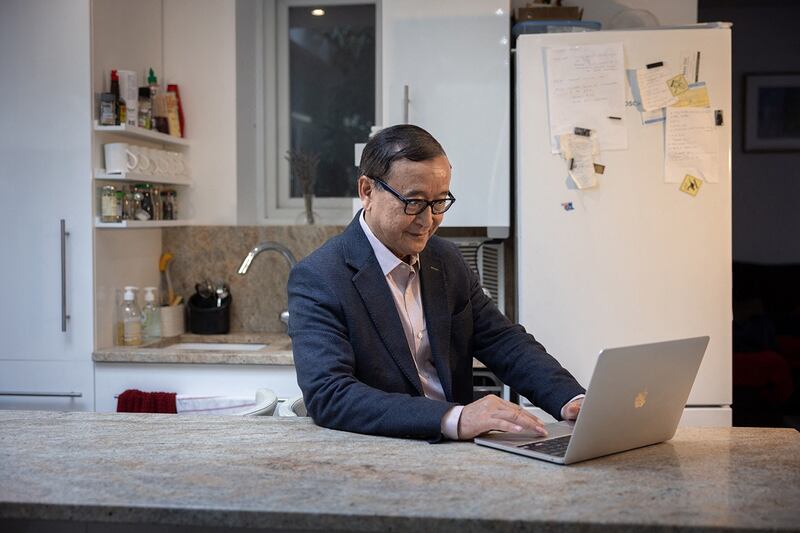
“It’s inconceivable that the canal can play a role in Cambodia’s international maritime trade without relying on the country’s only deep-water port at Sihanoukville,” Sam Rainsy wrote in a blog.
Blaming “Hun Sen’s vanity” for the project, Sam Rainsy noted that the real reasons for the canal project were not economic, but geostrategic and political.
Eyler said how quickly the canal progressed was a major question.
“It’s common though for projects to have a groundbreaking ceremony and then there is no further progress on the project for a long period,” he said.
“I’m willing to bet the Funan Techo canal will be one of them.”
Edited by Taejun Kang and Malcolm Foster.
This story has been updated to add comment from the first vice-chairman of the Council for the Development of Cambodia, Deputy Prime Minister Sun Chanthol, on the estimated number of affected households.
FOOTNOTE: The project has also had diplomatic repercussions on the decades-old alliance between Cambodia and Vietnam with China looking likely to emerge as the winner from their feud. The second part of the series will explore the impact on Vietnam-Cambodia relations.
